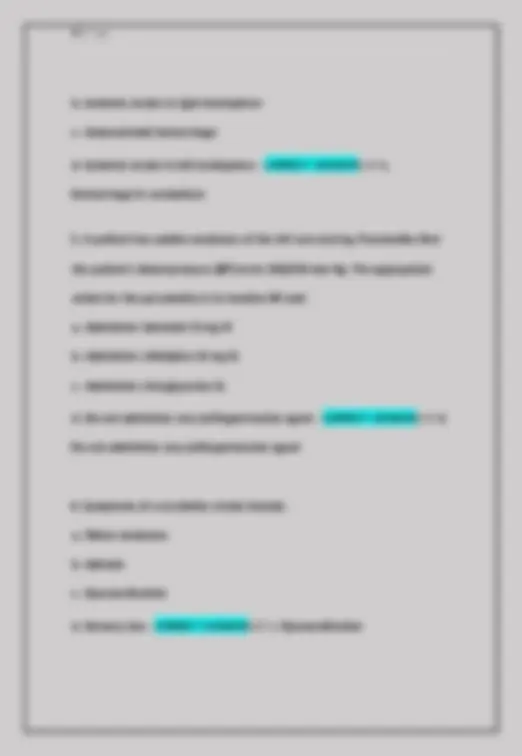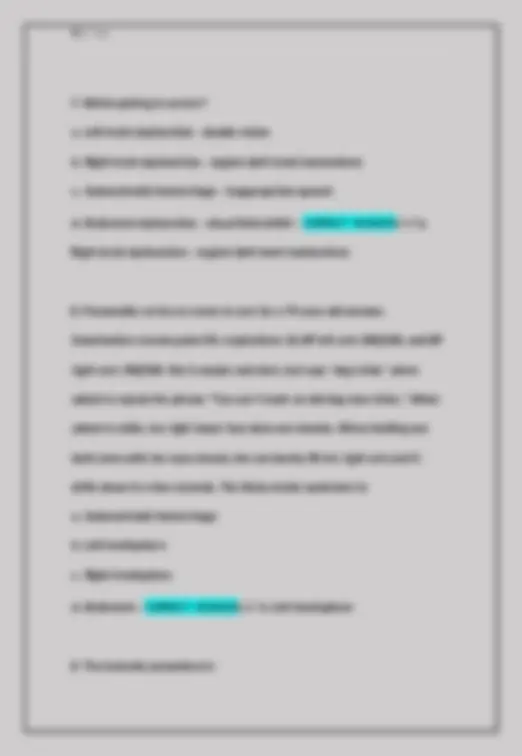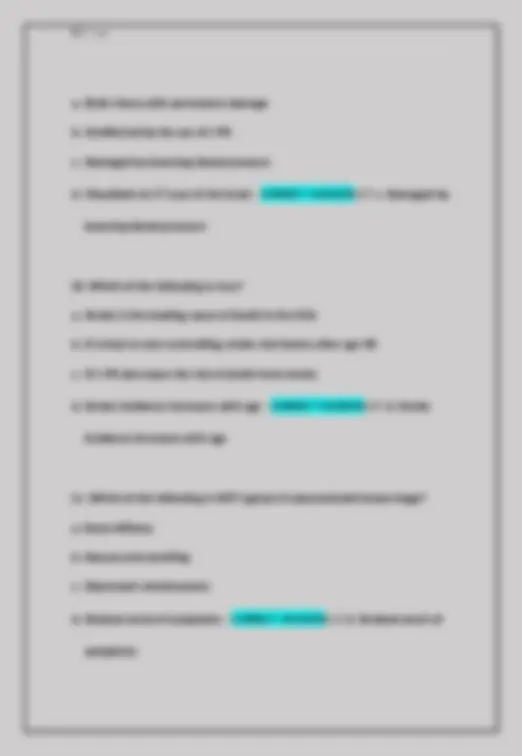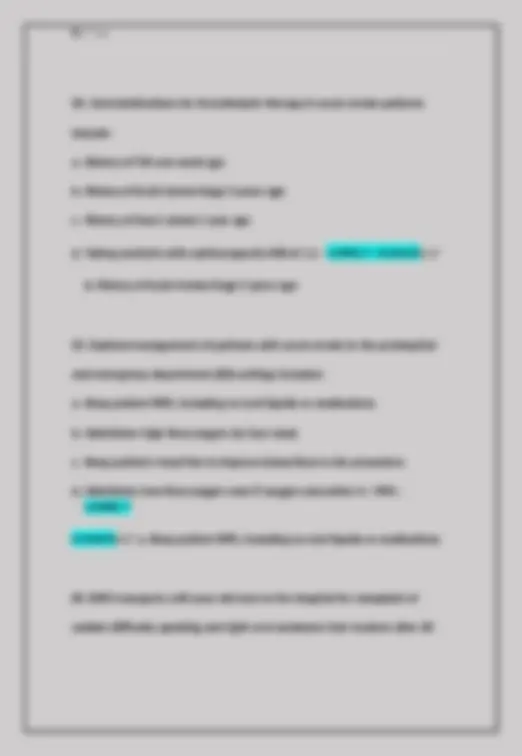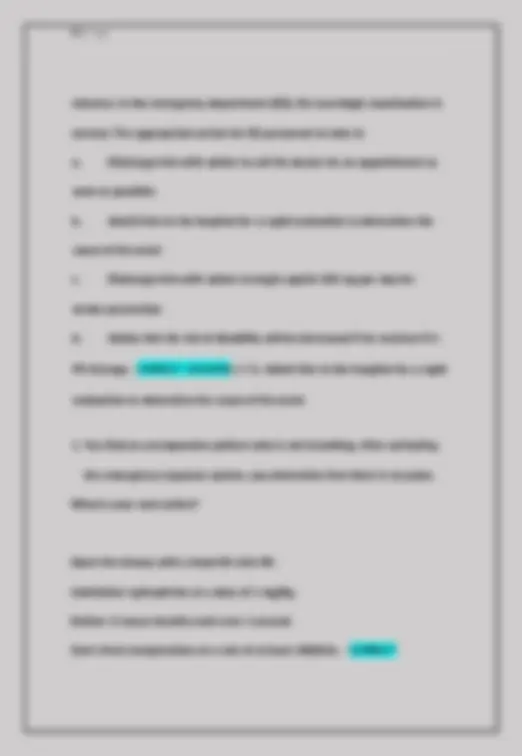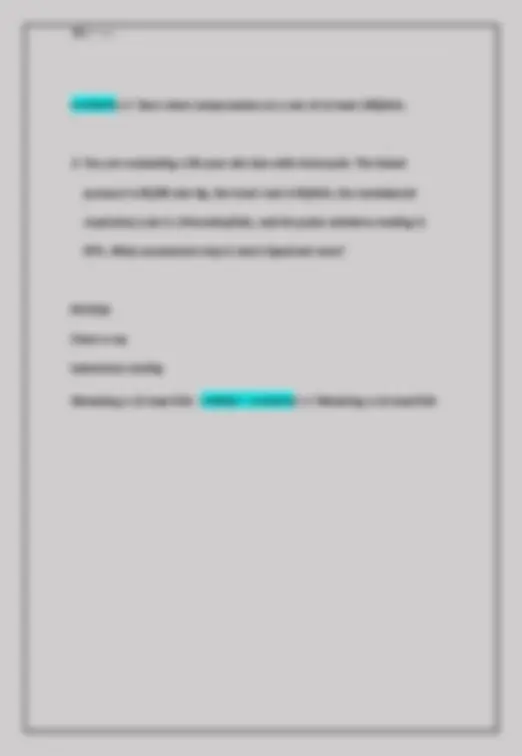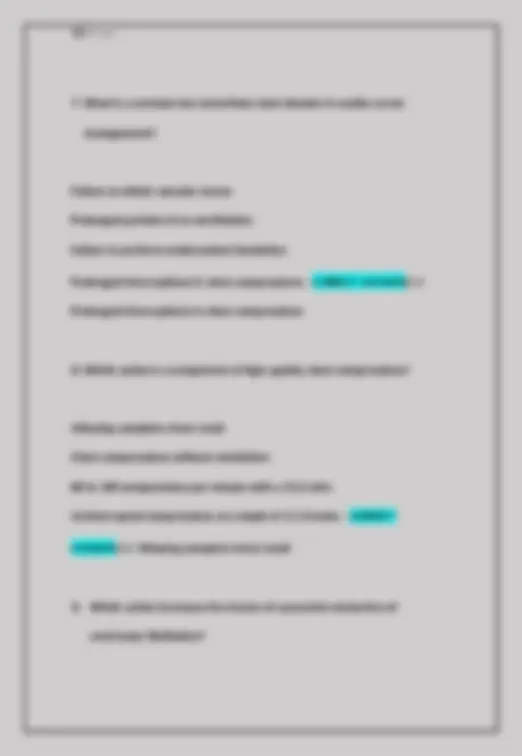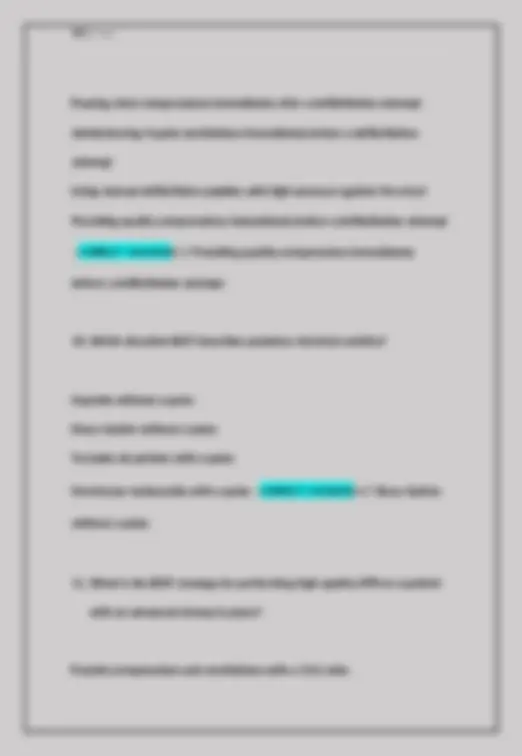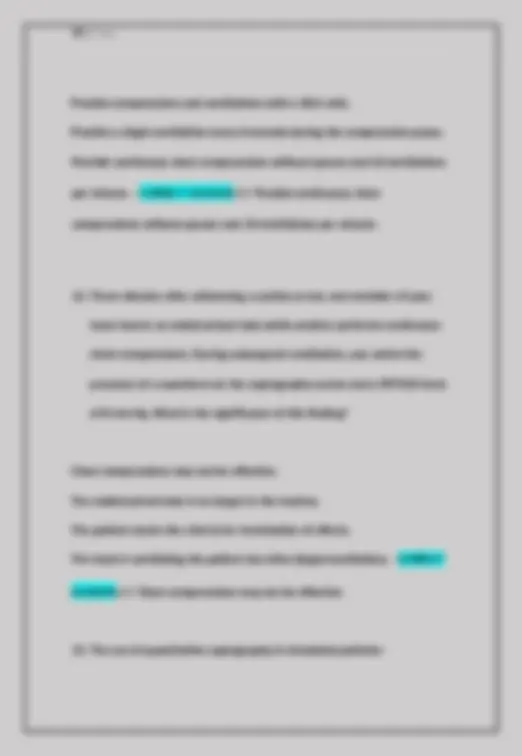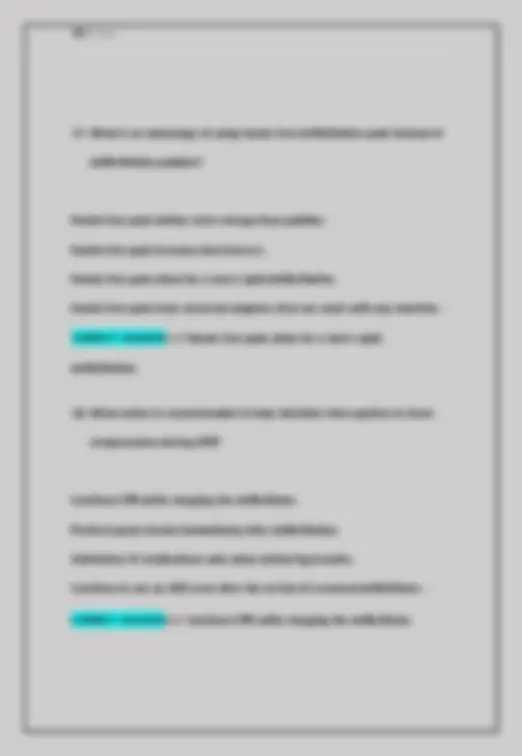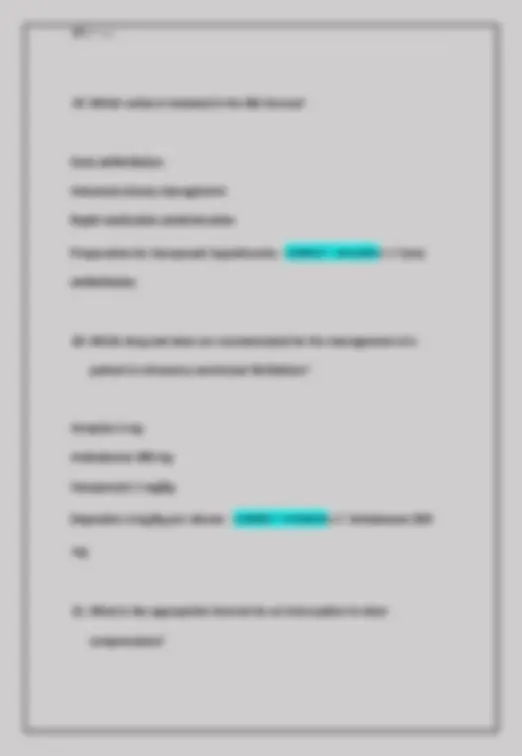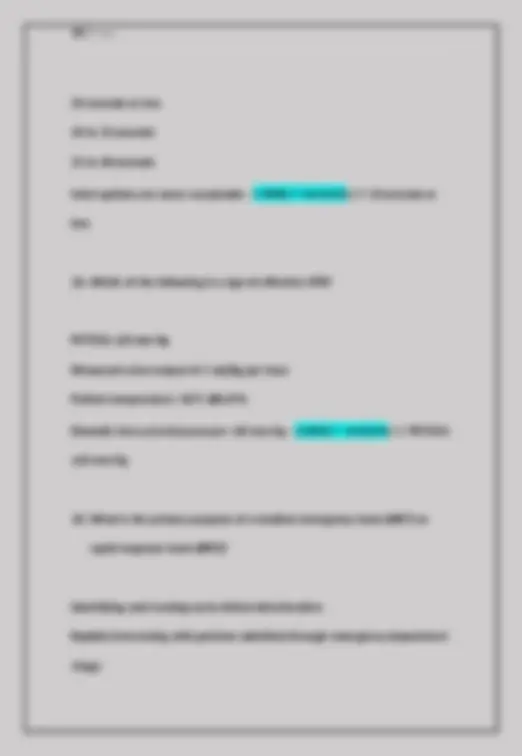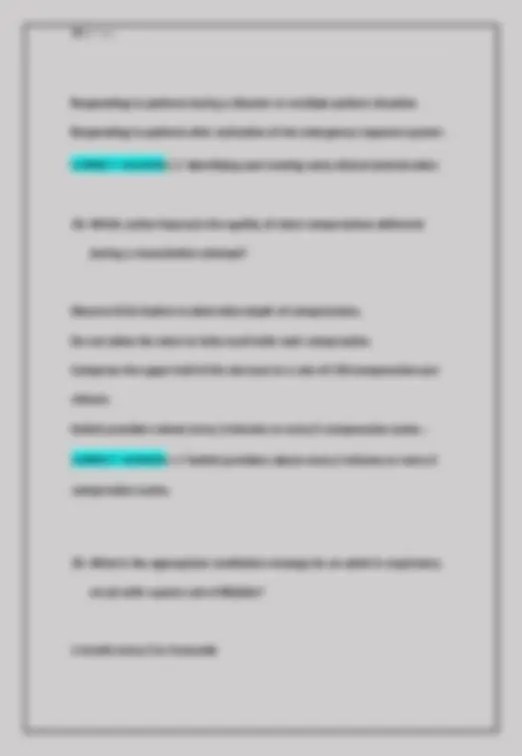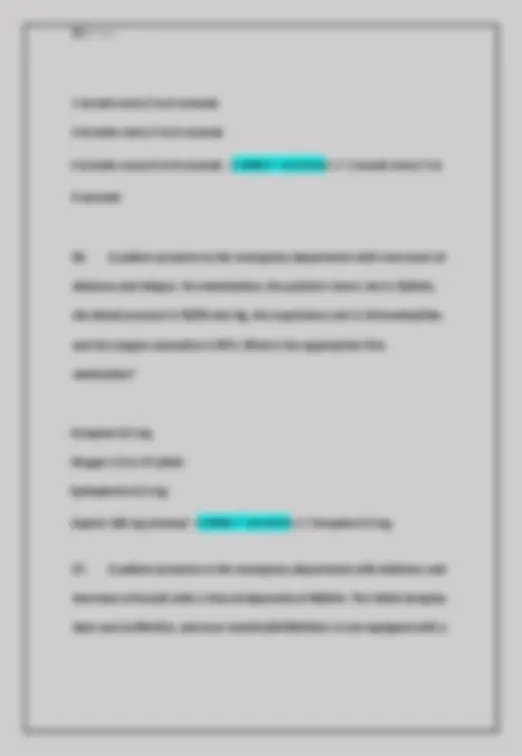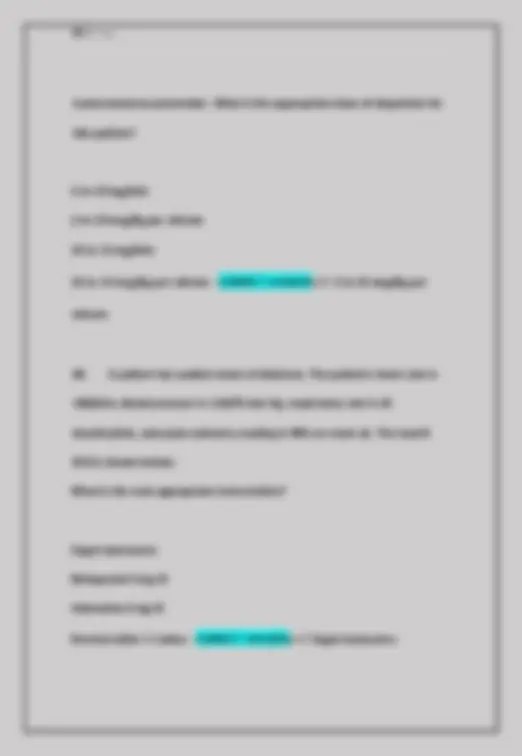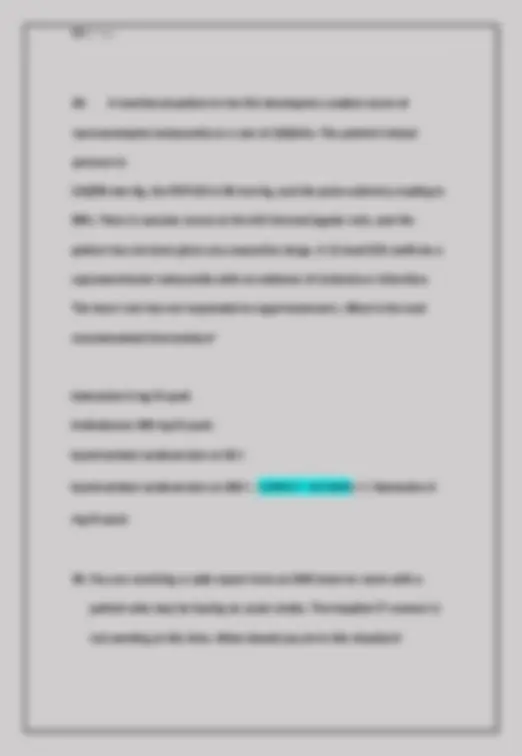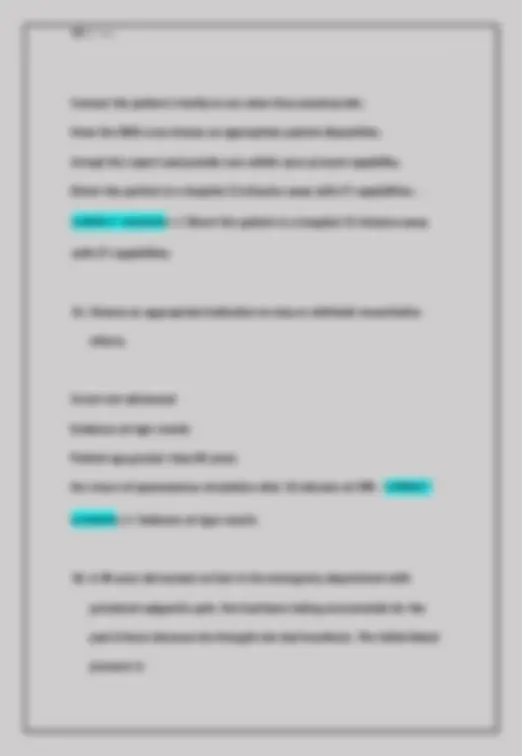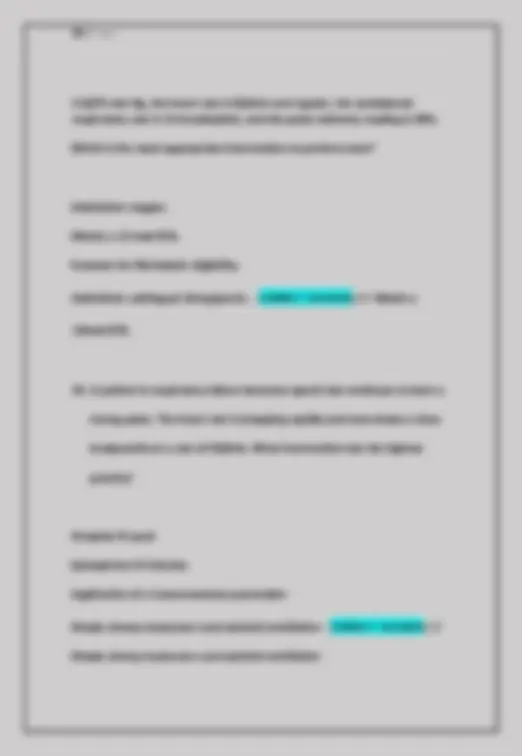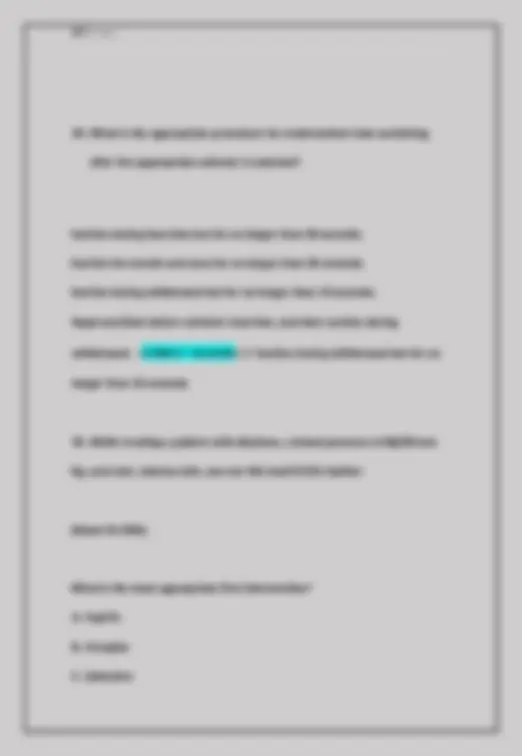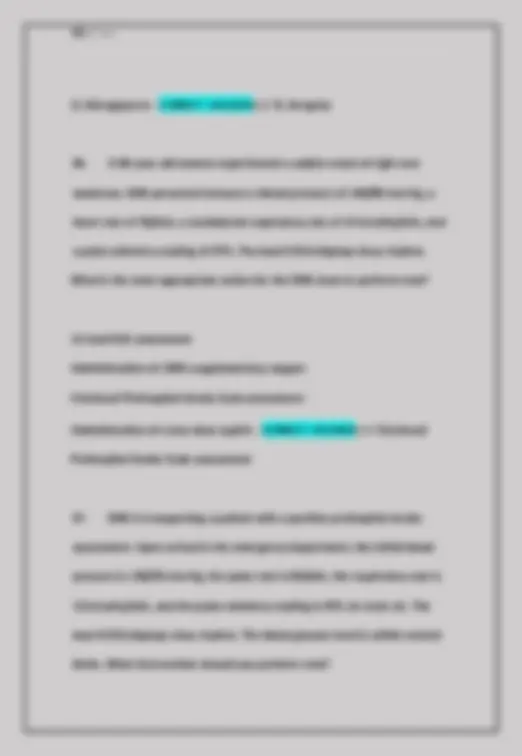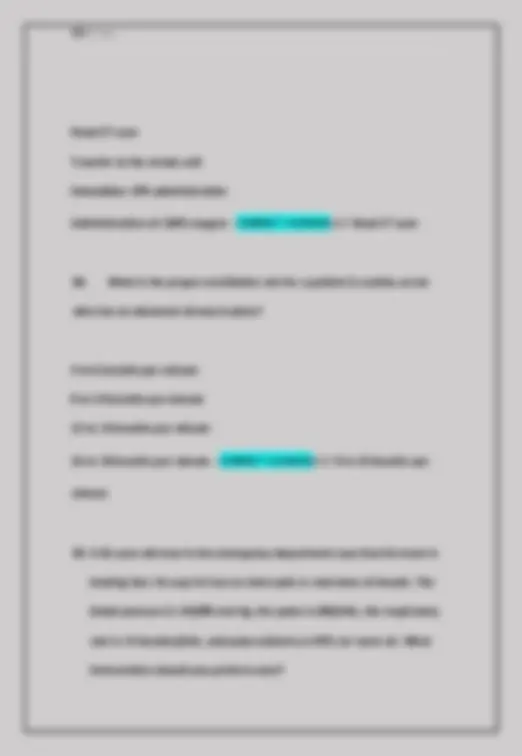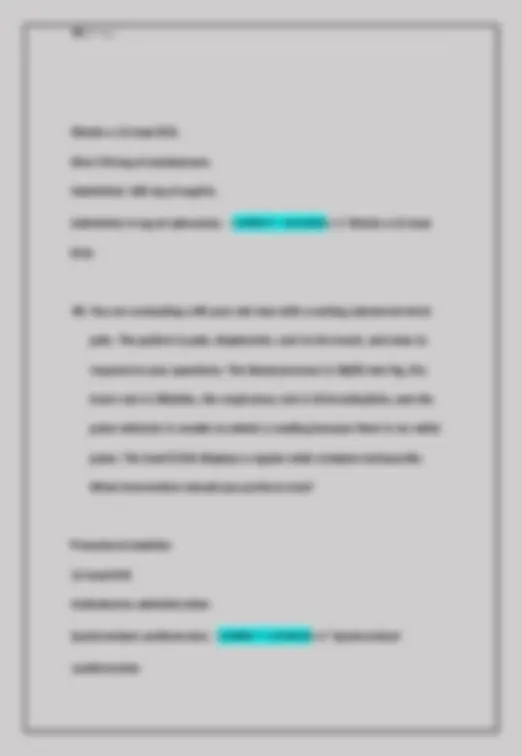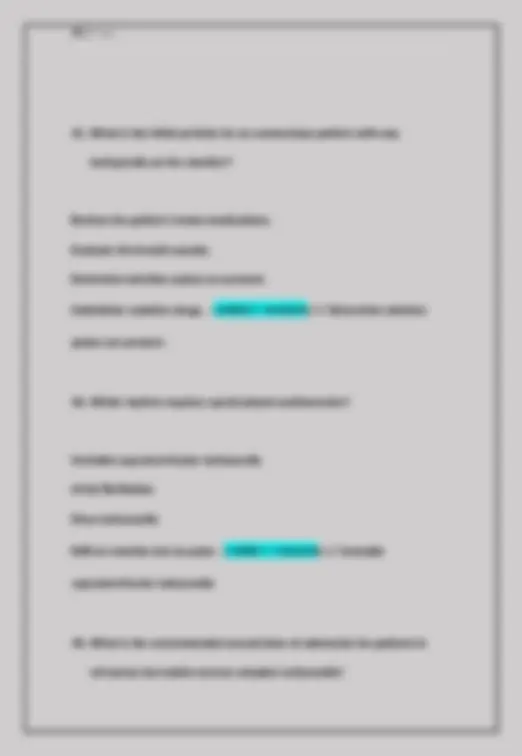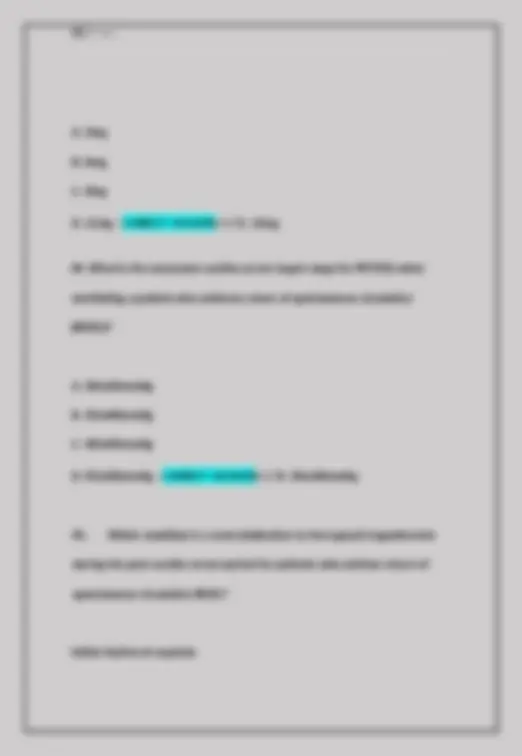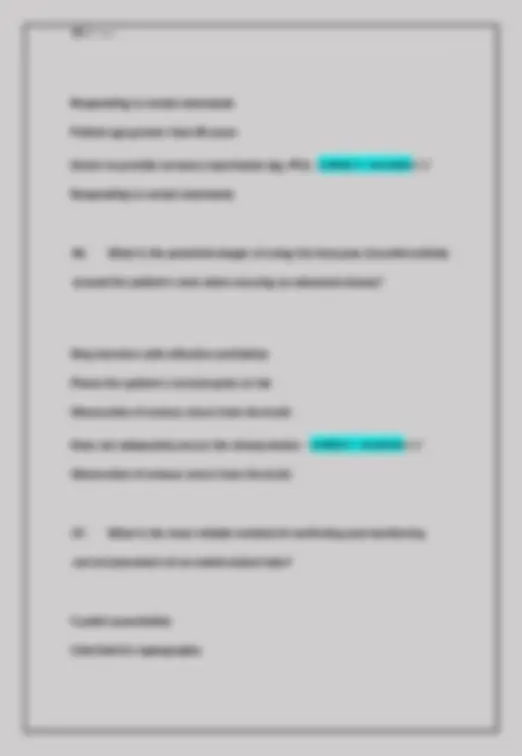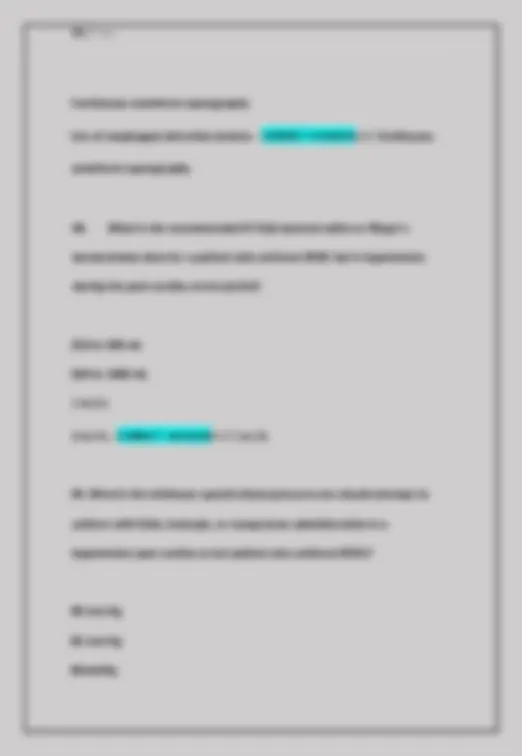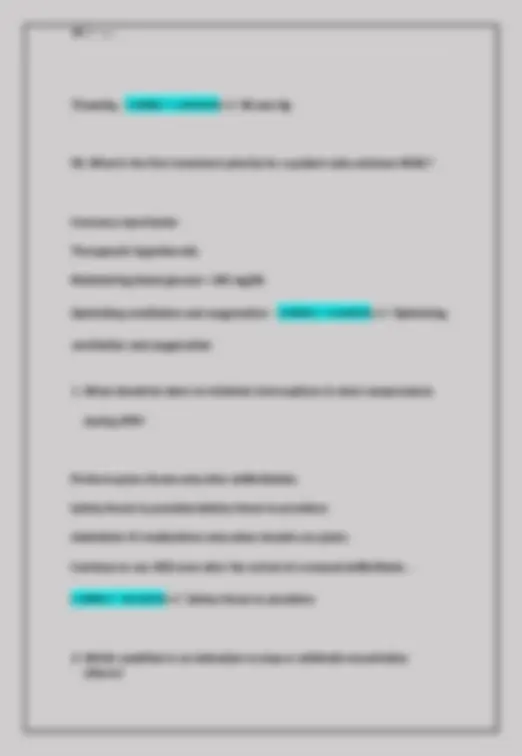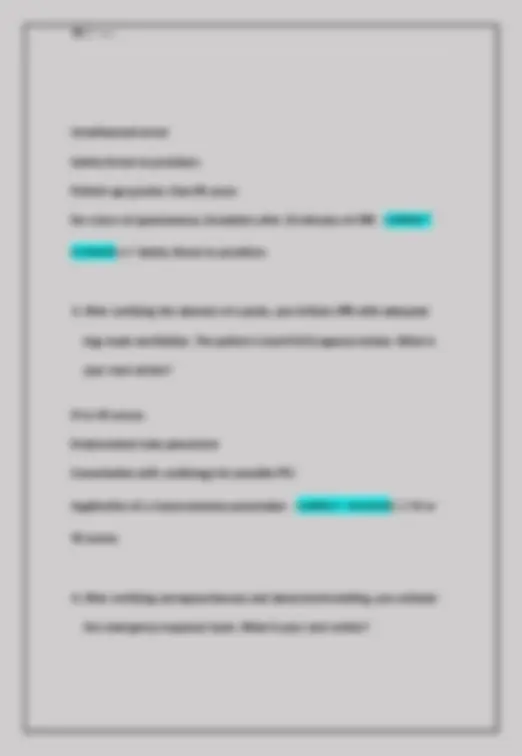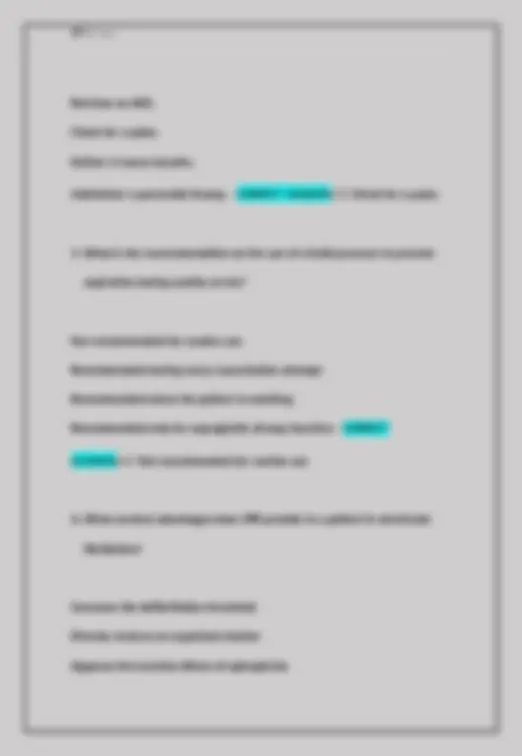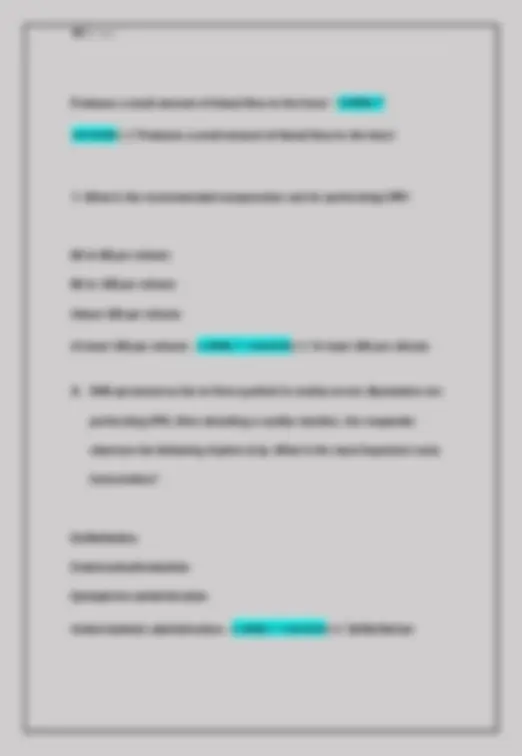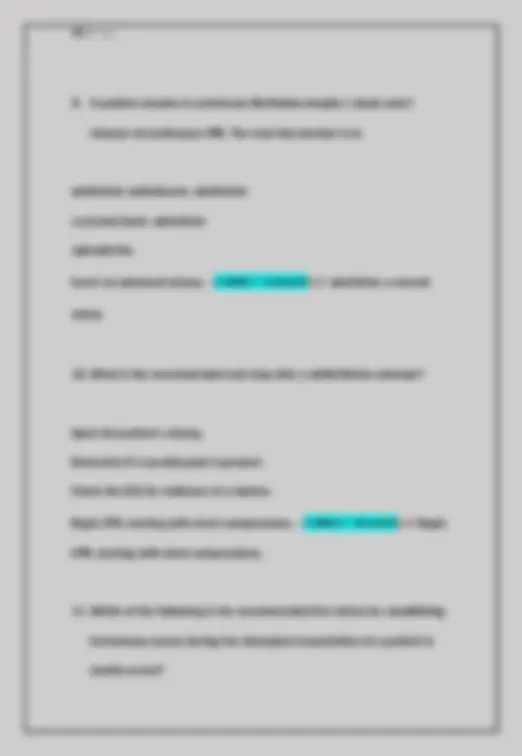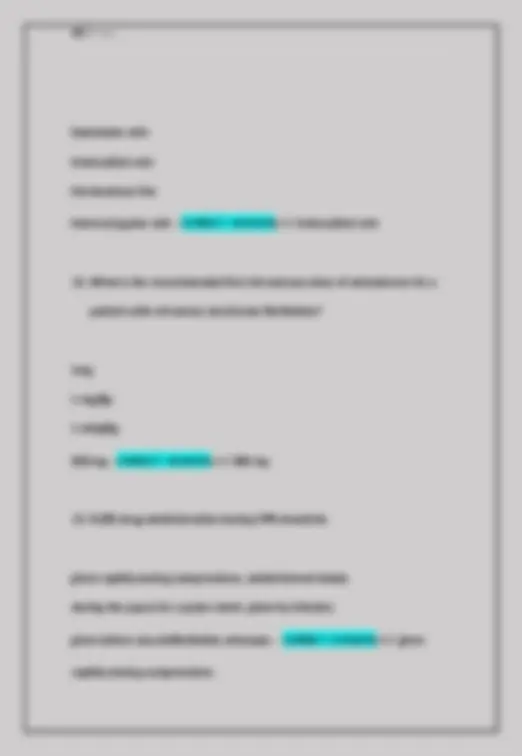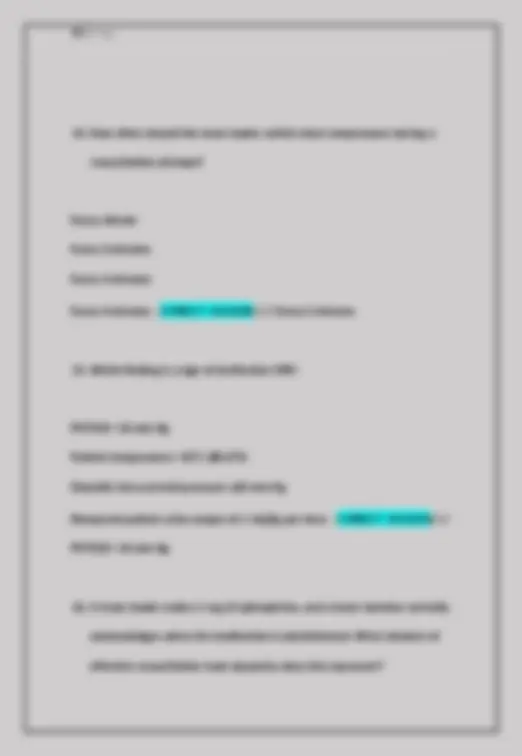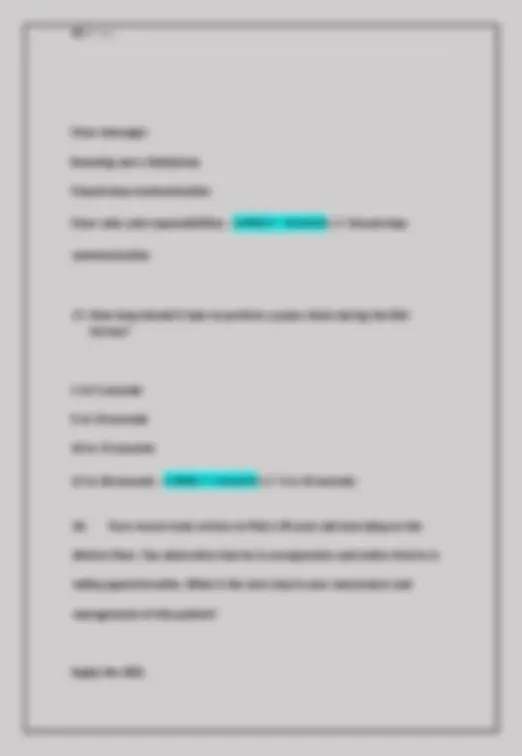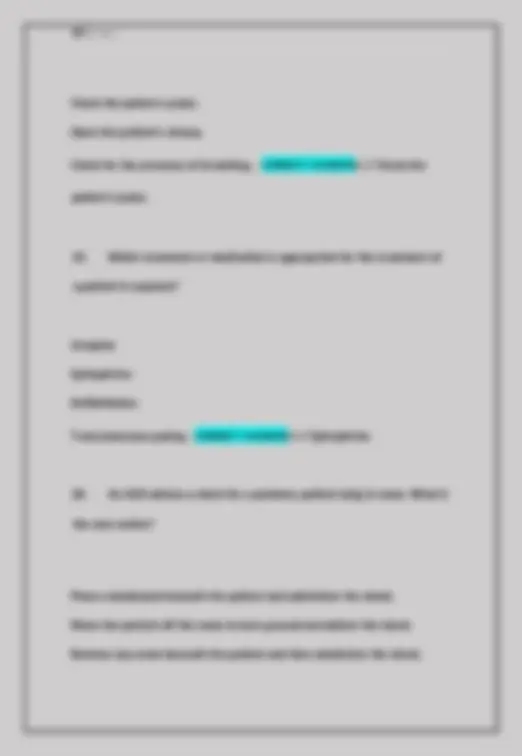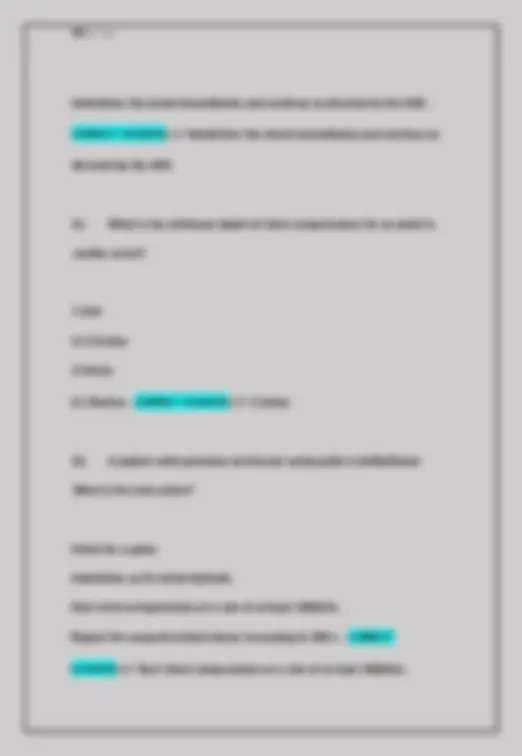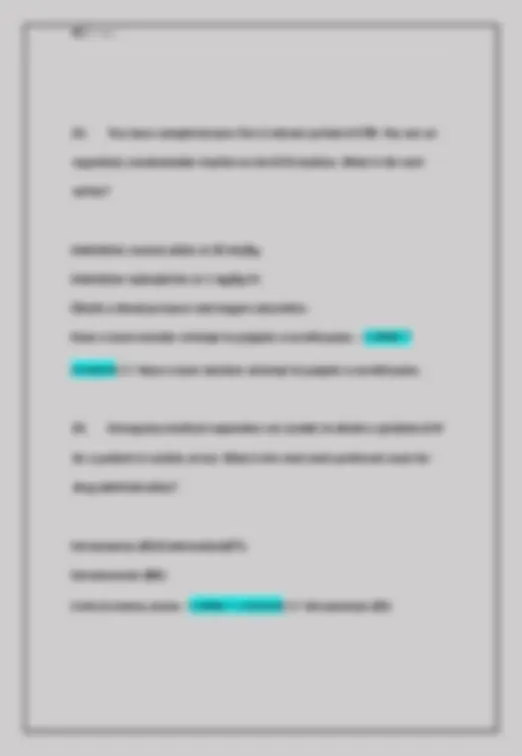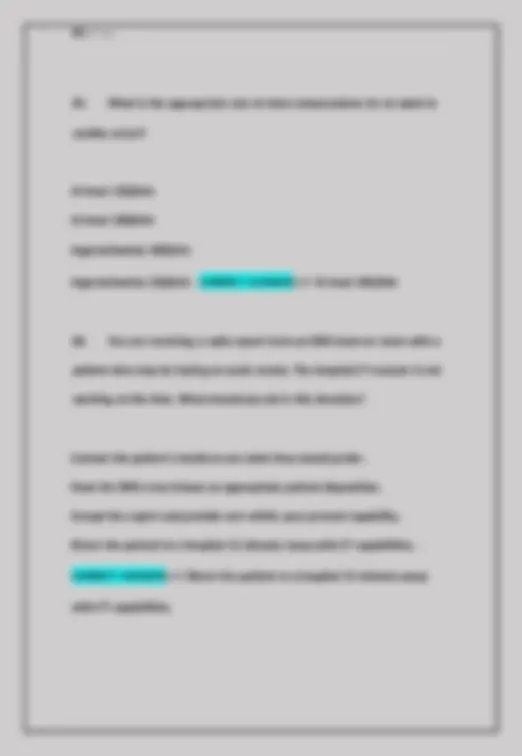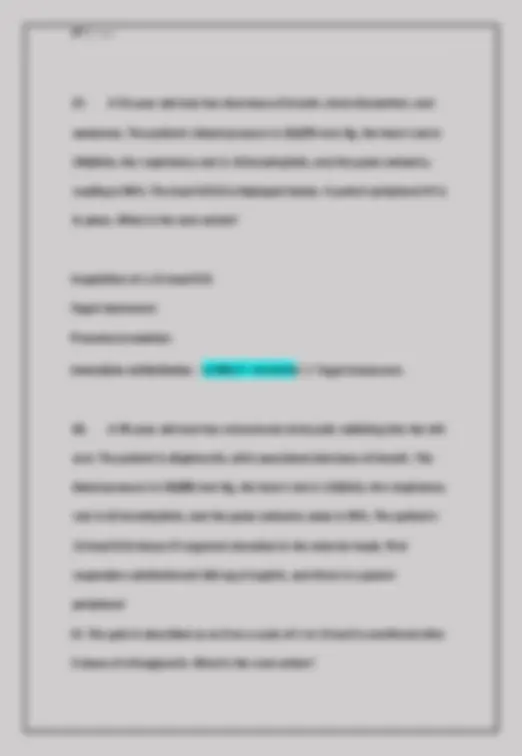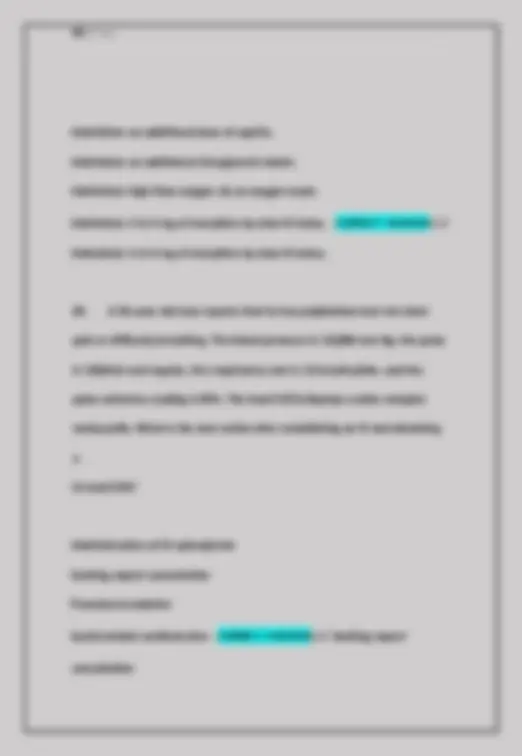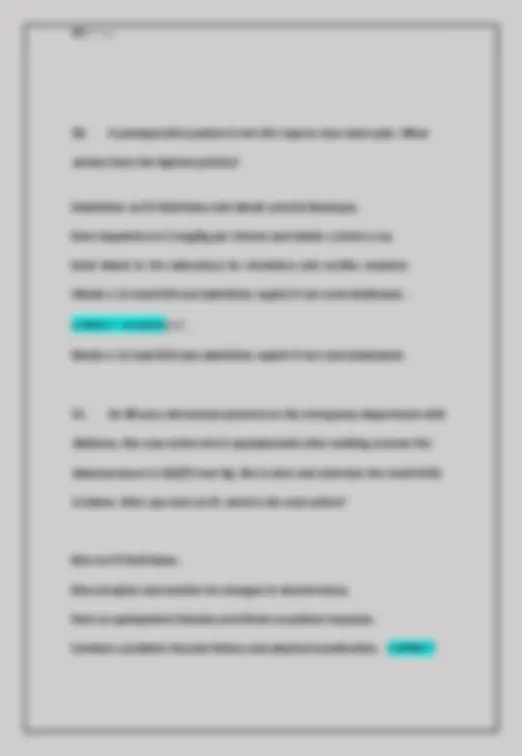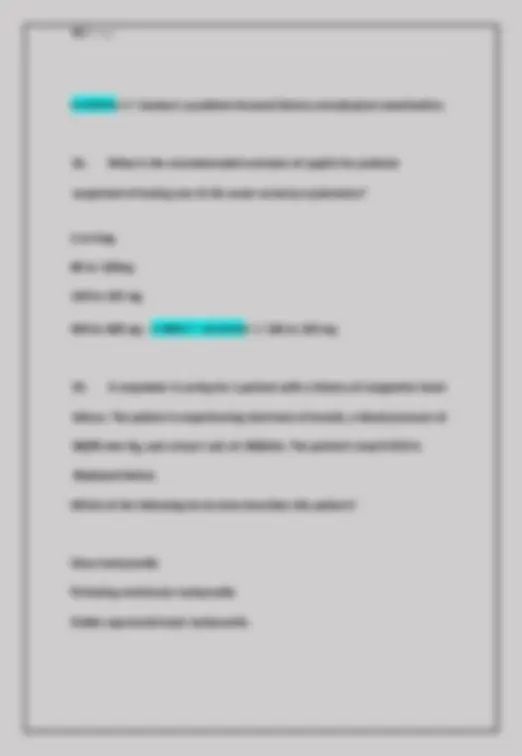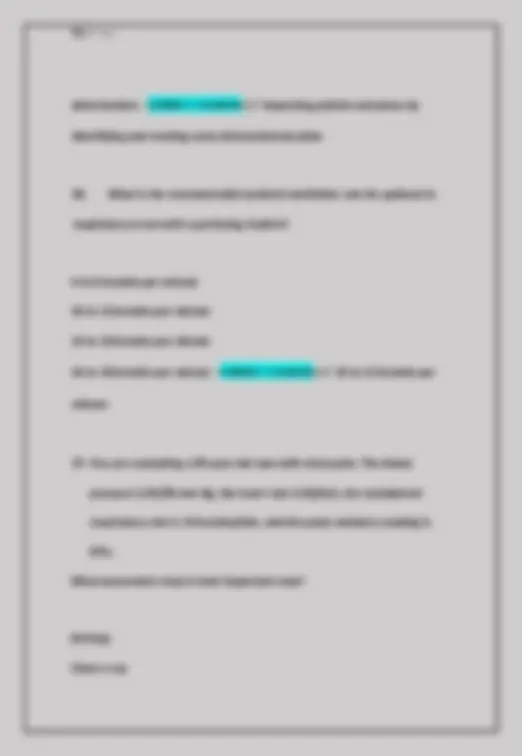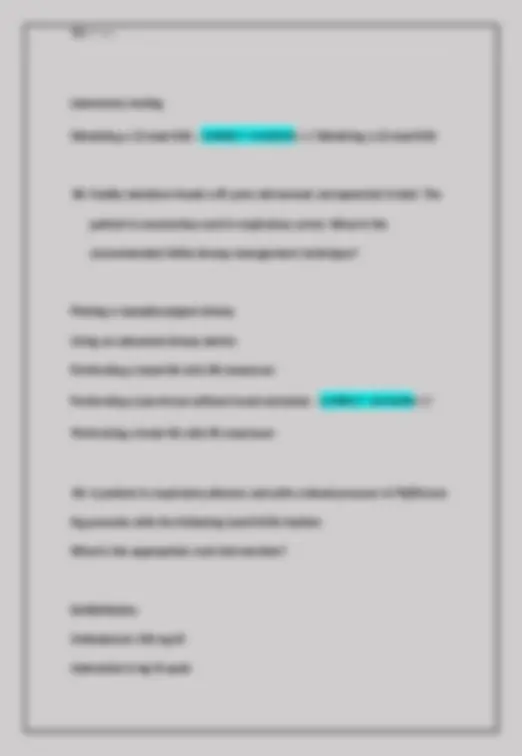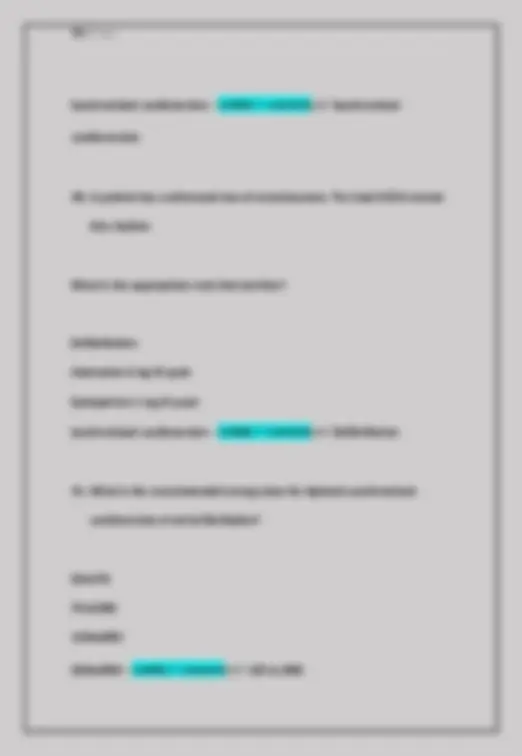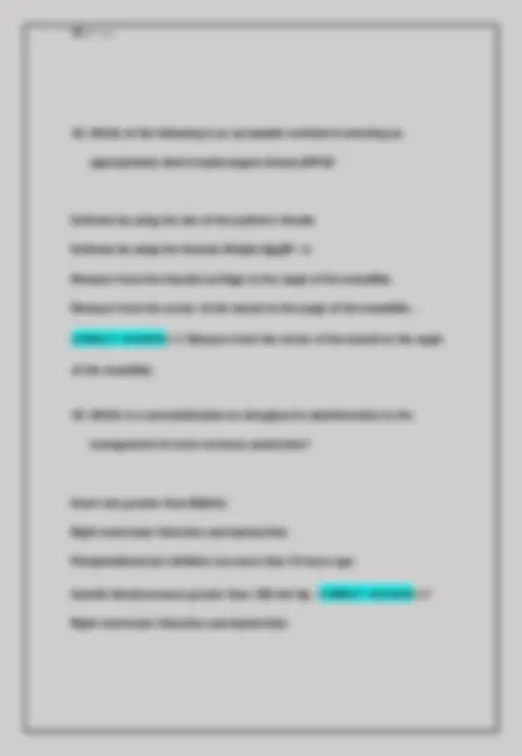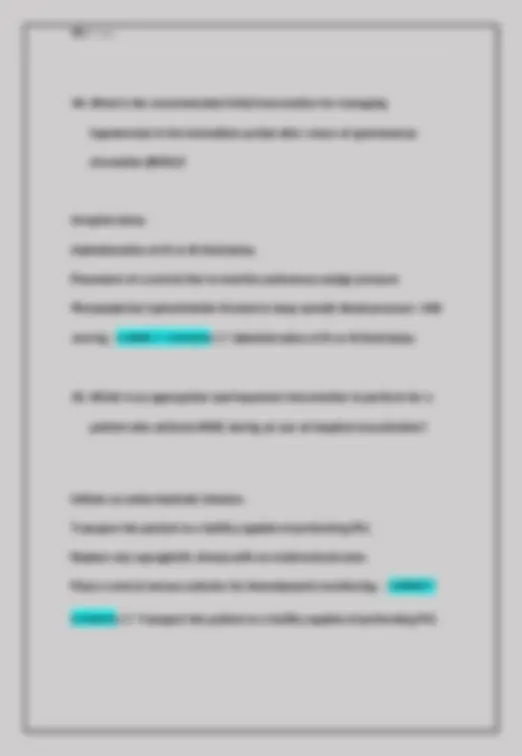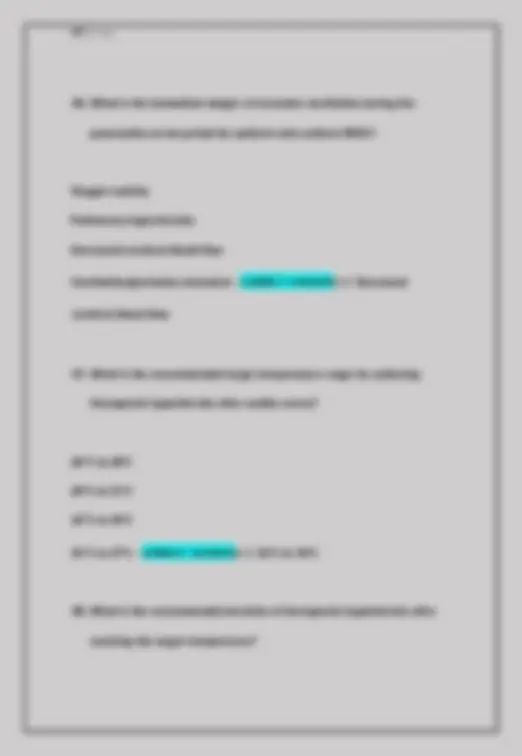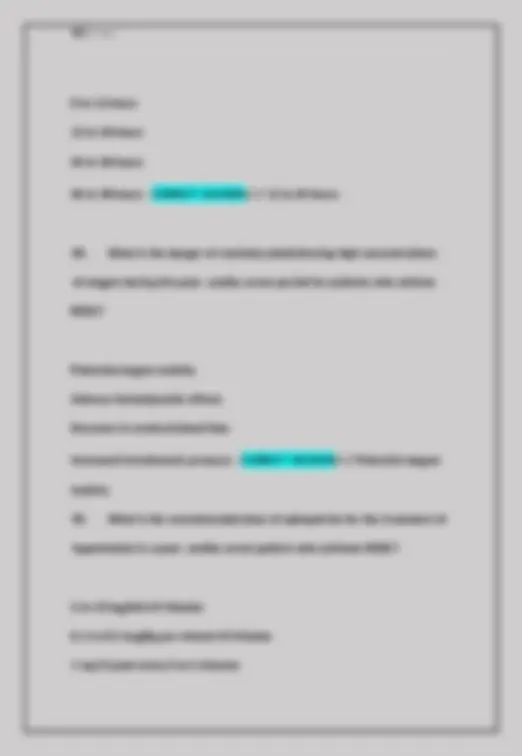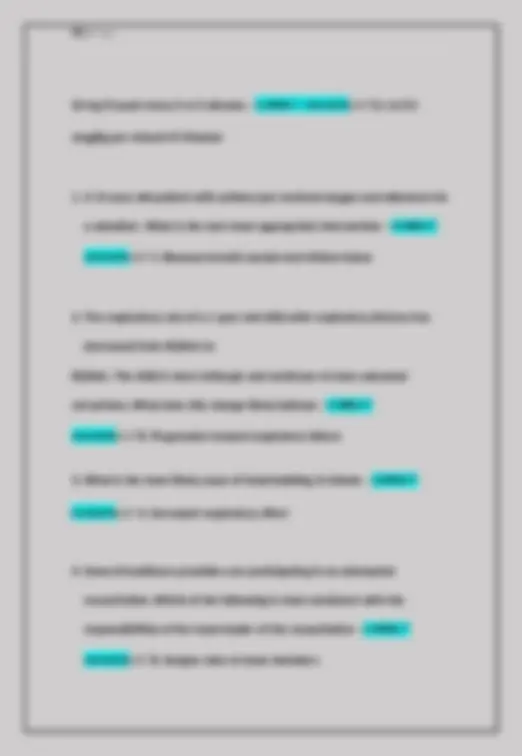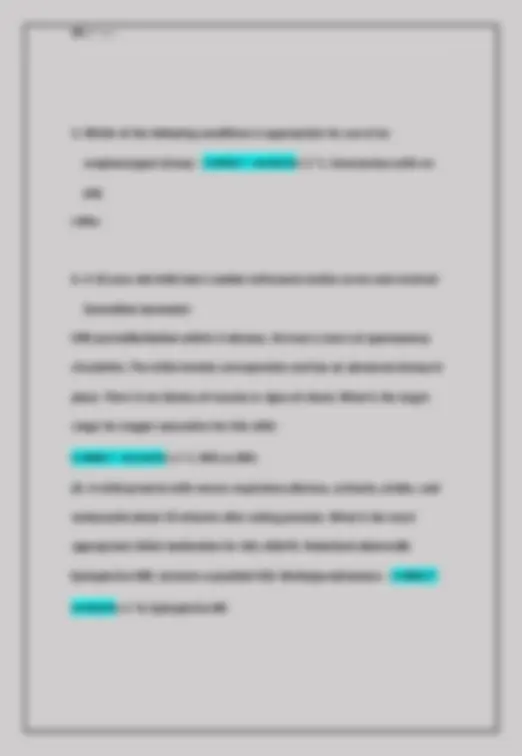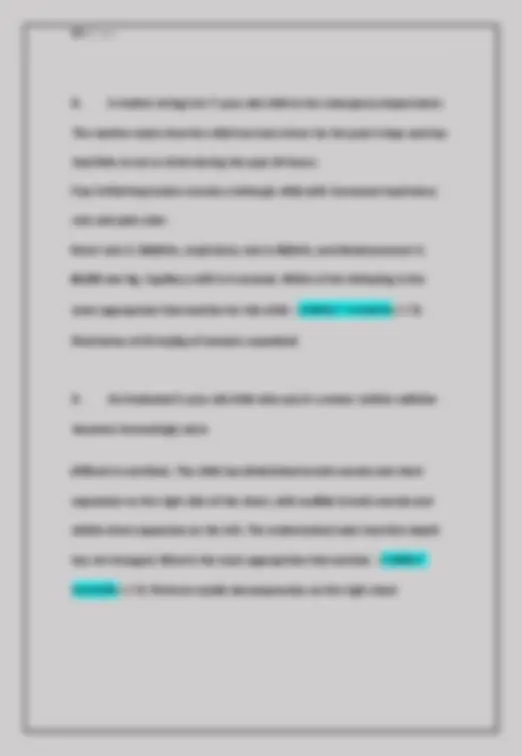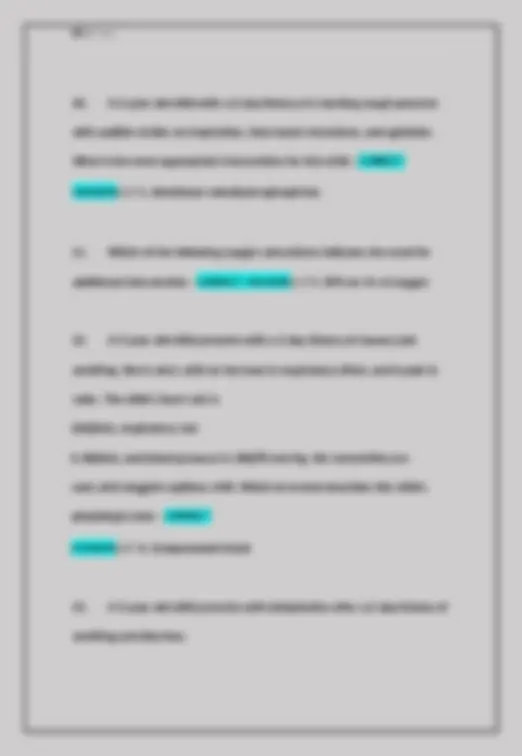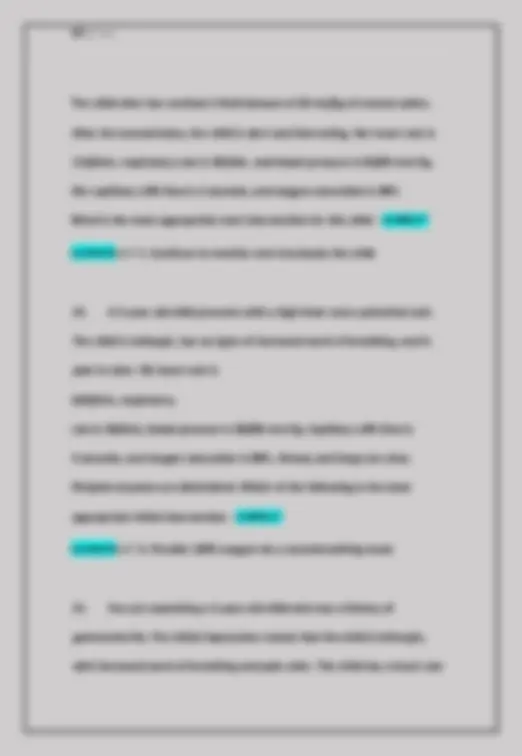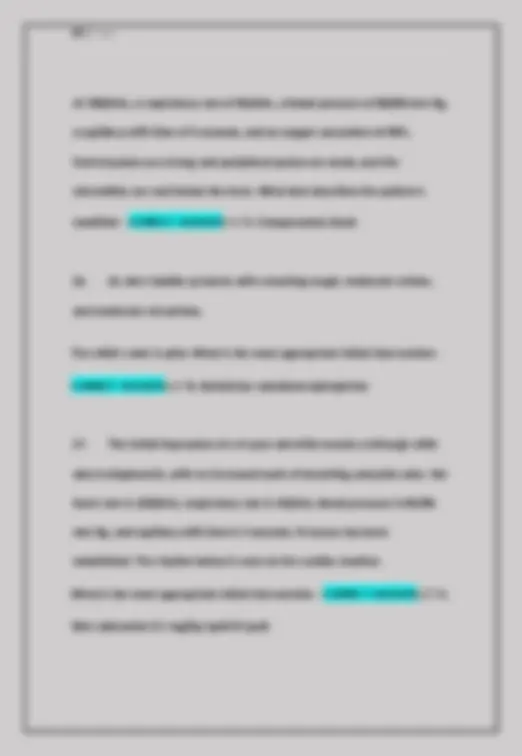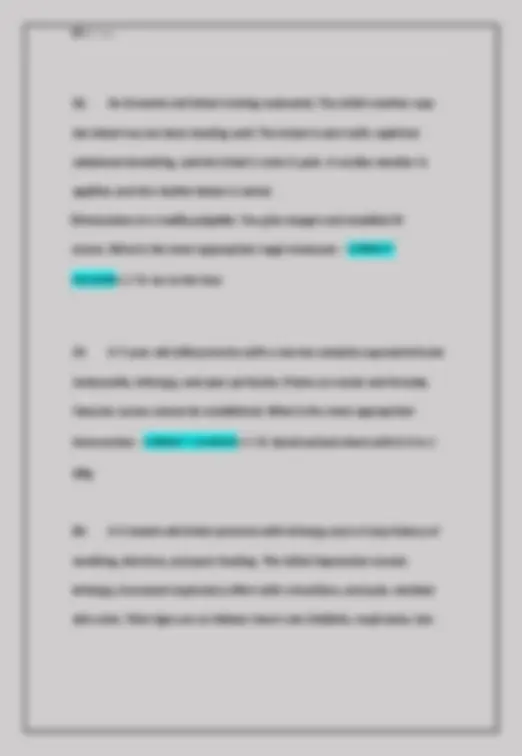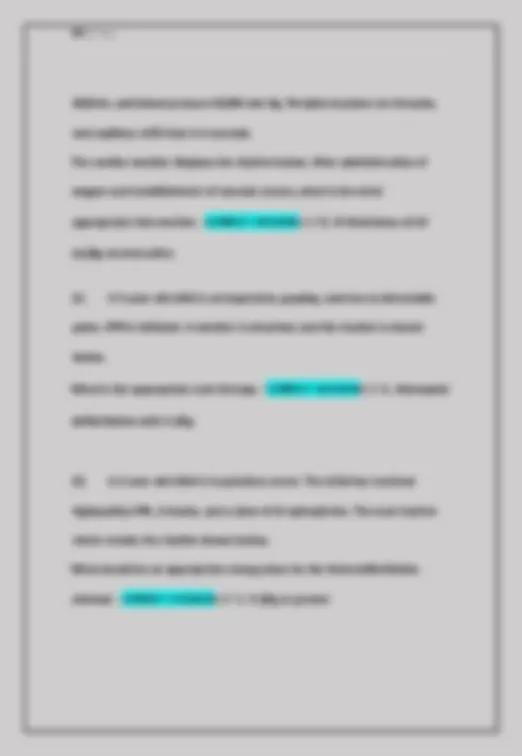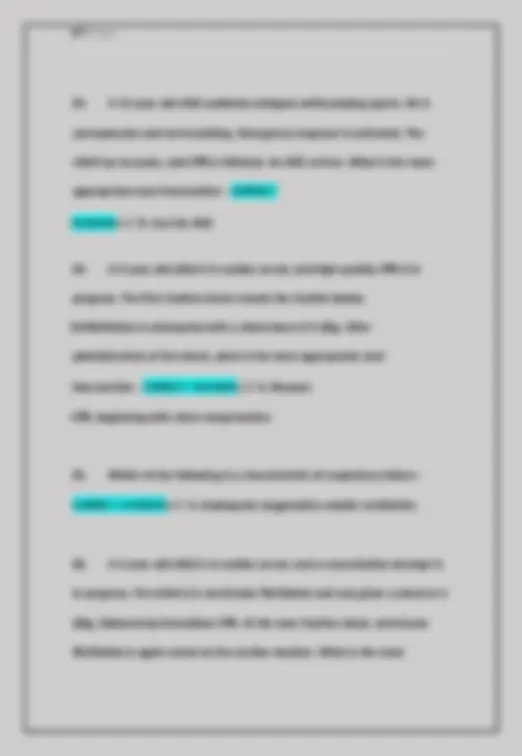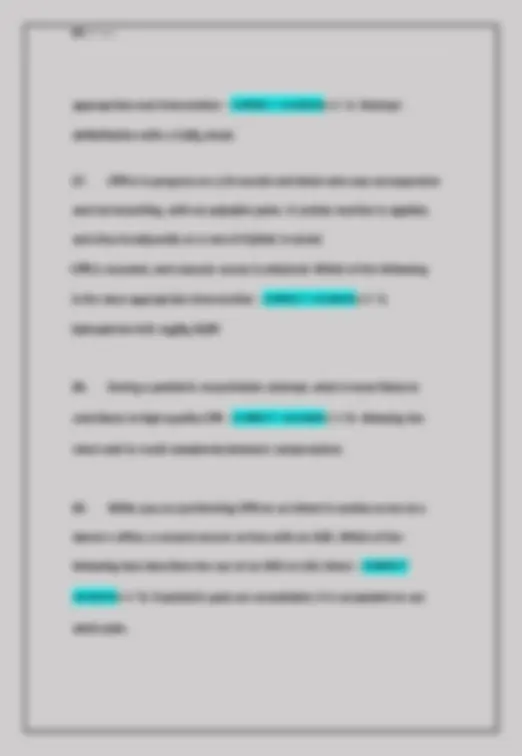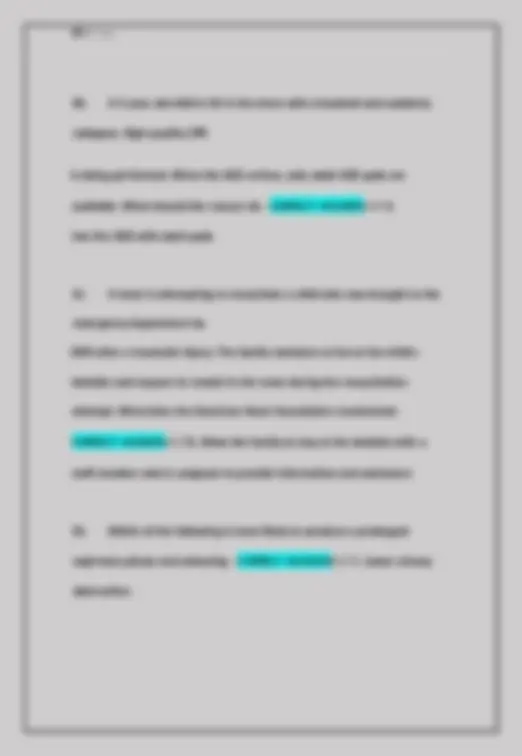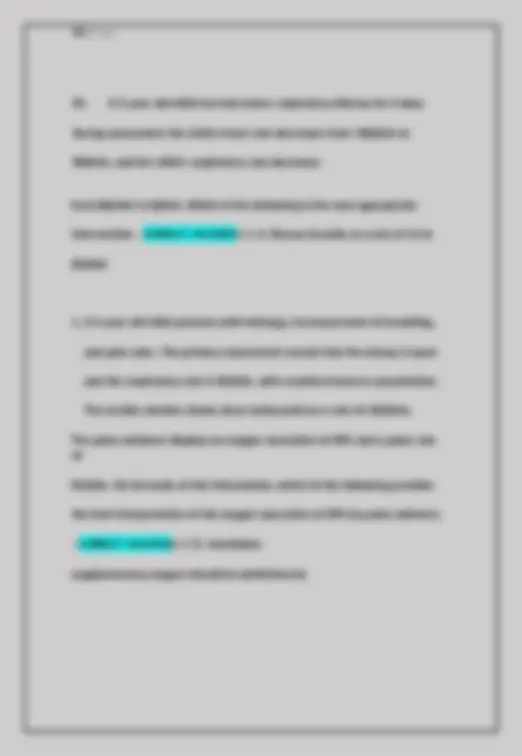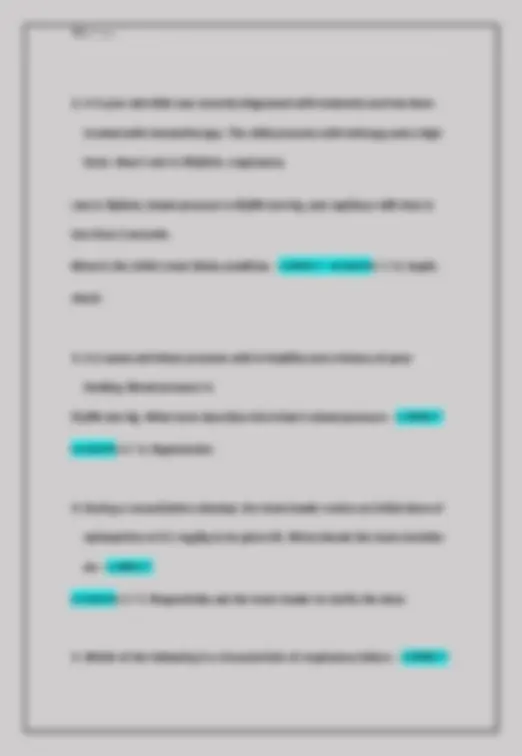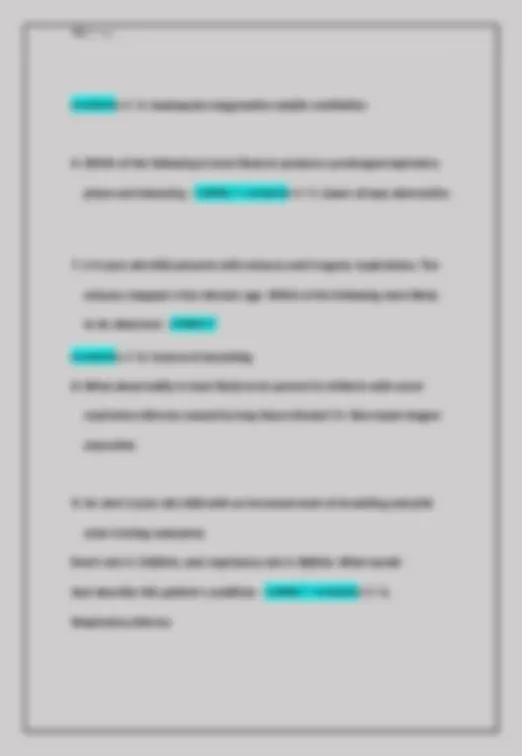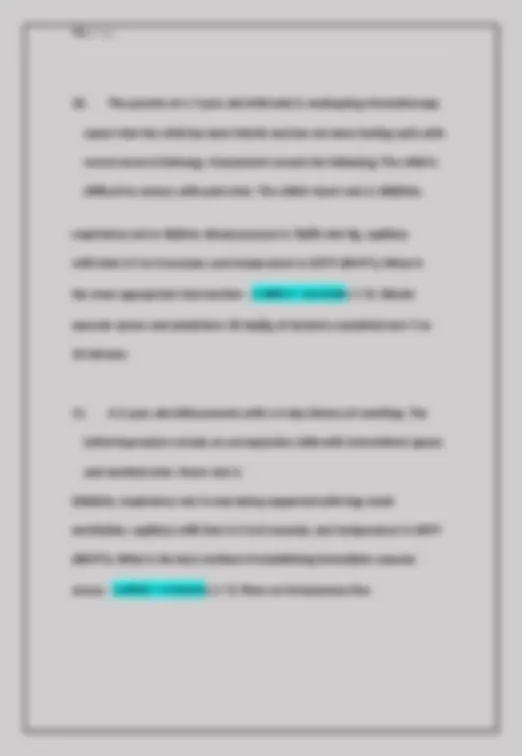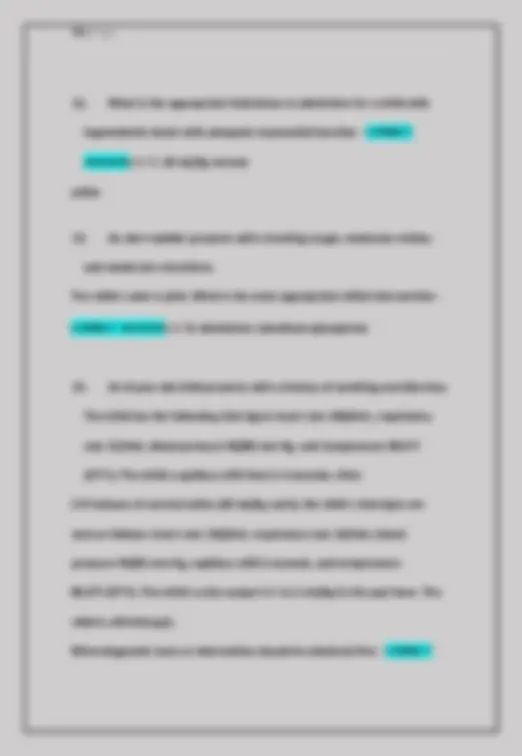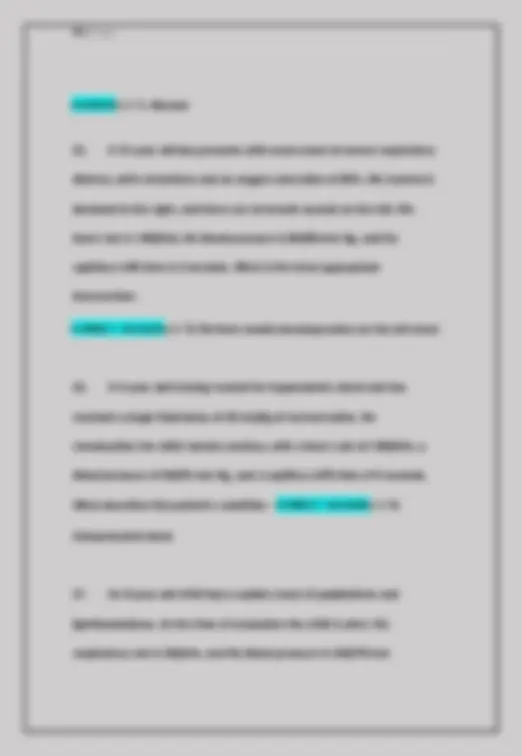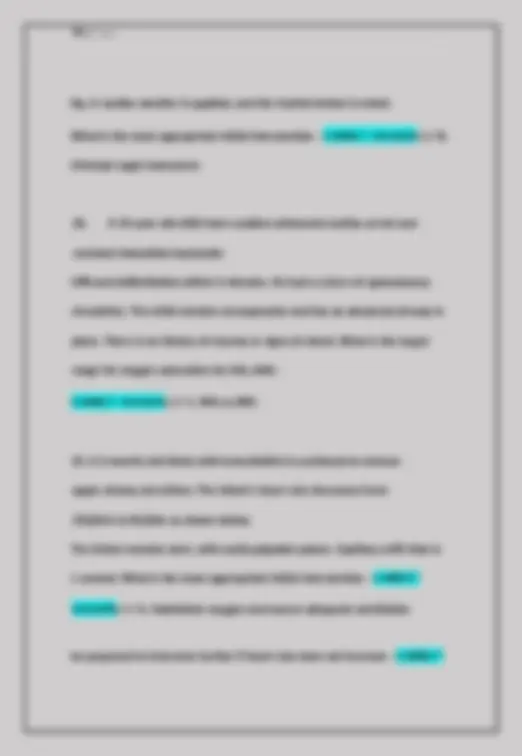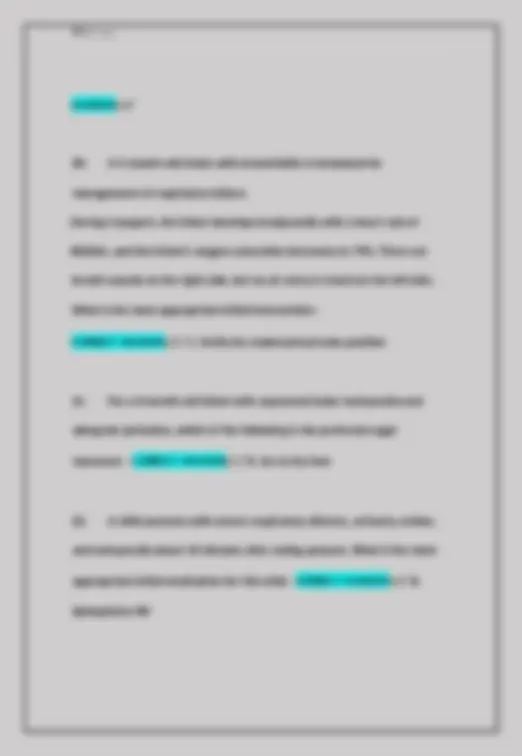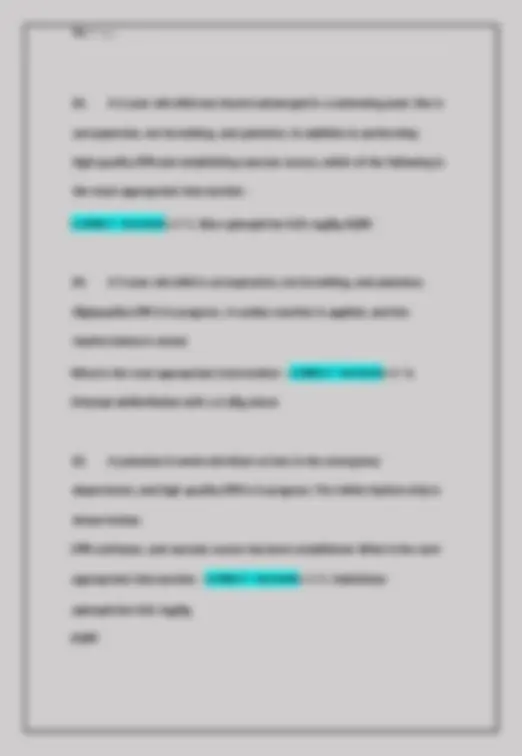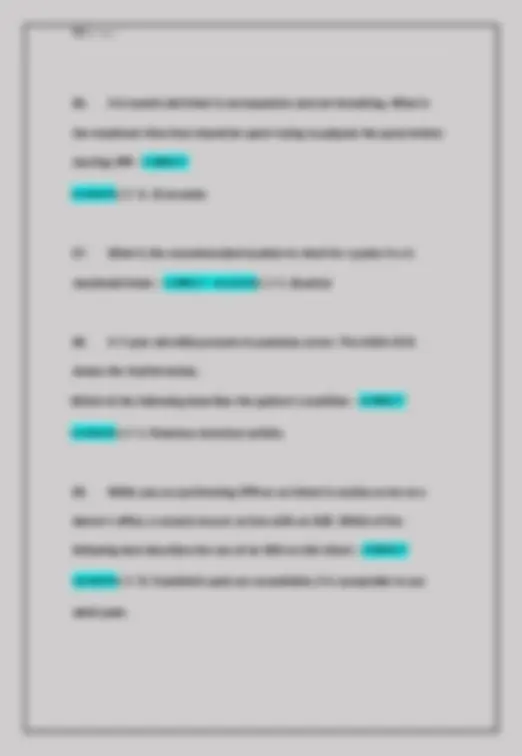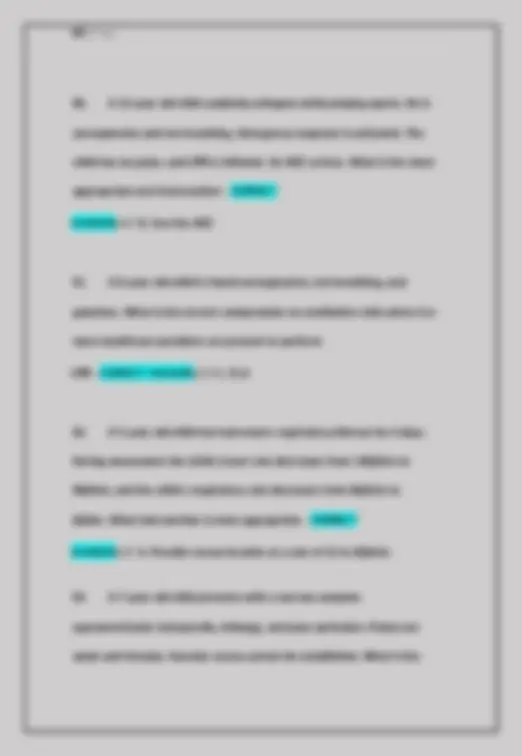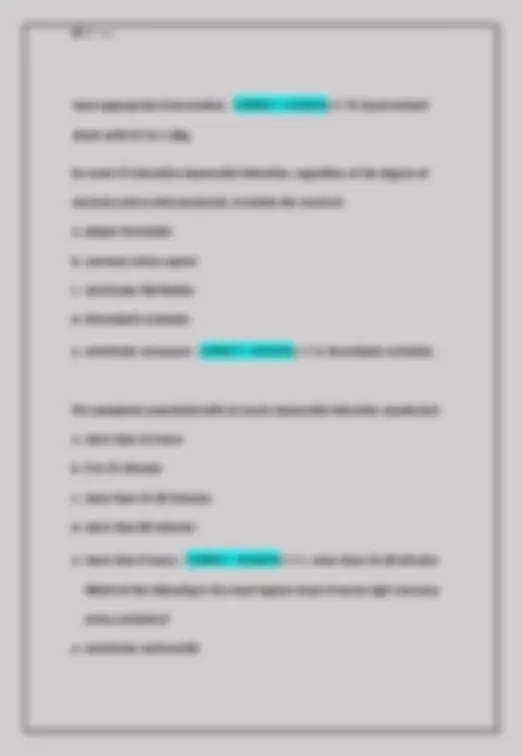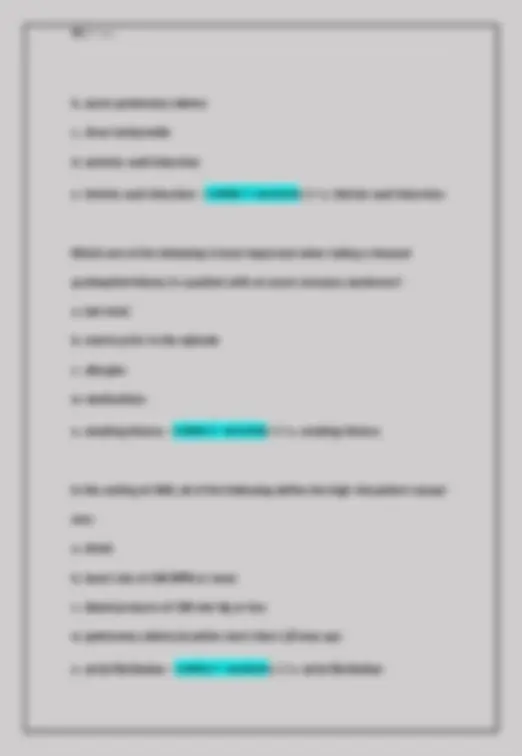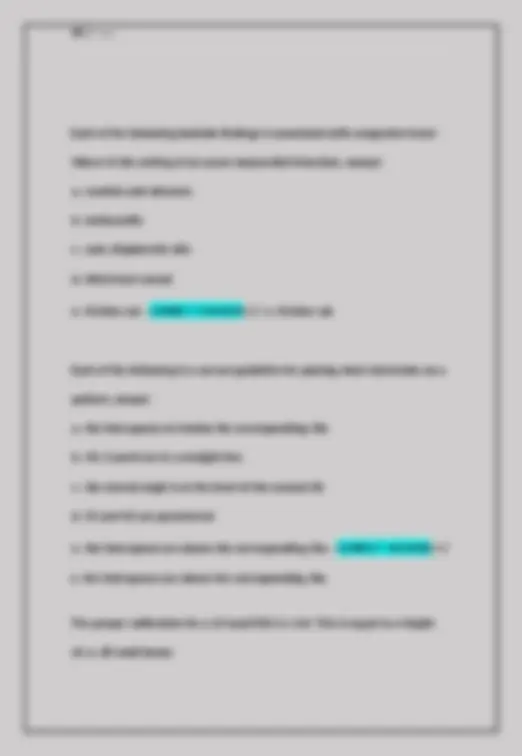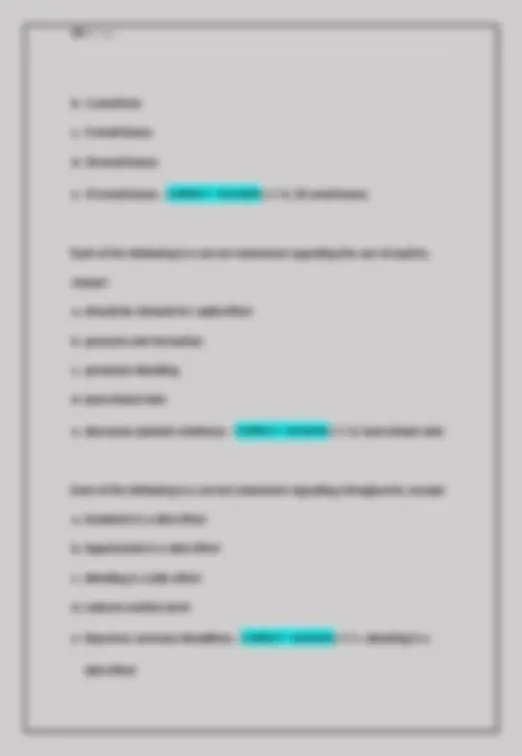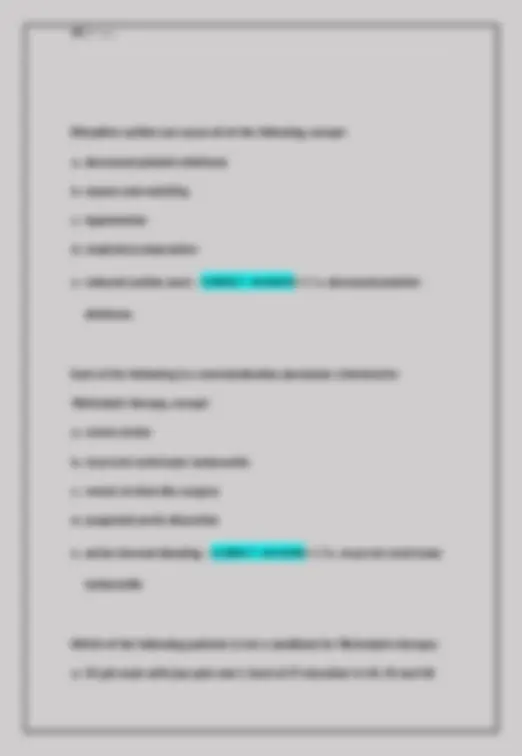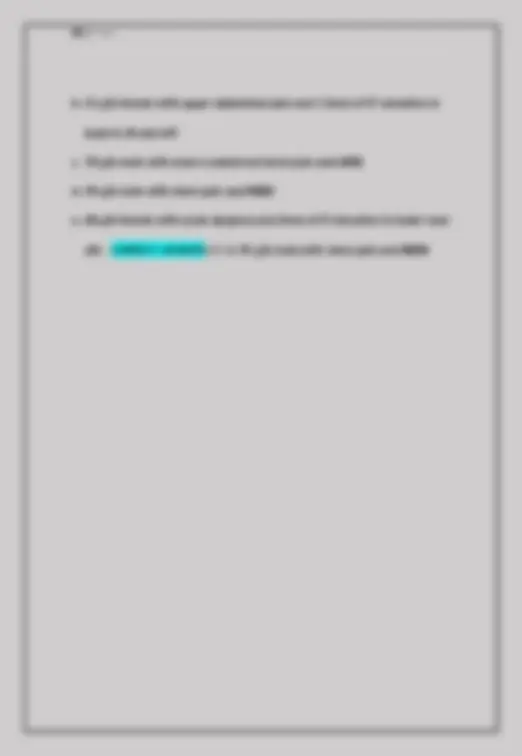Download AHA PALS (Pediatric Advanced Life Support) Exam 2025 | Latest Real Questions and Correct A and more Exams Health sciences in PDF only on Docsity!
AHA PALS (PEDIATRIC
ADVANCED LIFE SUPPORT)
EXAM 2025 LATEST REAL
QUESTIONS AND CORRECT
ANSWERS GRADE A
- The most common cause of intracerebral hemorrhage is: a. Vessel malformation b. Brain tumor c. Aneurysm rupture d. Chronic hypertension - CORRECT ANSWER✔✔ d. Chronic hypertension
- The MEND Exam: a. Is the ideal on-scene assessment tool for prehospital personnel b. Is too time consuming for use as a routine assessment tool for nurses c. Enhances communication between prehospital and hospital personnel d. Is best used when assessing patients with diffuse brain dysfunction - CORRECT ANSWER✔✔ c. Enhances communication between prehospital and hospital personnel
- Which one of the following statements is correct regarding the use of intravenous t-PA in ischemic stroke patients? a. Paramedics must be prepared to administer it in the field b. If used appropriately, it decreases risk of disability by 30% c. It is most beneficial within 3 hours, but may be given within 5 hours d. It is most beneficial if given to patients with minor symptoms - CORRECT ANSWER✔✔ b. If used appropriately, it decreases risk of disability by 30%
- EMS arrives on scene to care for a 56-year-old woman who complained of sudden headache, dizziness, and falling to the left when trying to walk. On assessment, she is lethargic but responds appropriately to verbal stimuli. When asked to repeat a phrase, she says the words correctly without slurring. When asked to smile, she elevates both sides of her face without difficulty. When asked to hold out her arms extended, she raises both arms without drifting down, but the left arm moves awkwardly. The likely stroke syndrome is: a. Hemorrhage in cerebellum
- Which pairing is correct? a. Left brain dysfunction - double vision b. Right brain dysfunction - neglect (left hemi-inattention) c. Subarachnoid hemorrhage - inappropriate speech d. Brainstem dysfunction - visual field deficit - CORRECT ANSWER✔✔ b. Right brain dysfunction - neglect (left hemi-inattention)
- Paramedics arrive on scene to care for a 74-year-old woman. Examination reveals pulse 90, respirations 18, BP left arm 200/100, and BP right arm 190/100. She is awake and alert, but says "dog tricks" when asked to repeat the phrase "You can't teach an old dog new tricks." When asked to smile, her right lower face does not elevate. When holding out both arms with her eyes closed, she can barely lift her right arm and it drifts down in a few seconds. The likely stroke syndrome is: a. Subarachnoid hemorrhage b. Left hemisphere c. Right hemisphere d. Brainstem - CORRECT ANSWER✔✔ b. Left hemisphere
- The ischemic penumbra is:
a. Brain tissue with permanent damage b. Unaffected by the use of t-PA c. Damaged by lowering blood pressure d. Visualized on CT scan of the brain - CORRECT ANSWER✔✔ c. Damaged by lowering blood pressure
- Which of the following is true? a. Stroke is the leading cause of death in the USA b. It is best to start controlling stroke risk factors after age 40 c. IV t-PA decreases the risk of death from stroke d. Stroke incidence increases with age - CORRECT ANSWER✔✔ d. Stroke incidence increases with age
- Which of the following is NOT typical of subarachnoid hemorrhage? a. Neck stiffness b. Nausea and vomiting c. Depressed consciousness d. Gradual onset of symptoms - CORRECT ANSWER✔✔ d. Gradual onset of symptoms
- In a patient suspected of having an acute stroke, which one of the following is the best way to differentiate between an ischemic or hemorrhagic cause? a. The history b. The neurologic examination c. Blood pressure values d. A CT scan of the brain - CORRECT ANSWER✔✔ d. A CT scan of the brain
- Which of the following is NOT a risk factor for ischemic stroke? a. Cocaine use b. Brain tumor c. Excessive alcohol use d. Hypercoagulable state - CORRECT ANSWER✔✔ b. Brain tumor
- Ischemic stroke accounts for approximately what percent of all strokes? a. 20% b. 50% c. 80% d. > 95% - CORRECT ANSWER✔✔ c. 80%
- Contraindications for thrombolytic therapy in acute stroke patients include: a. History of TIA one week ago b. History of brain hemorrhage 5 years ago c. History of heart attack 1 year ago d. Taking warfarin with subtherapeutic INR of 1.2 - CORRECT ANSWER✔✔ b. History of brain hemorrhage 5 years ago
- Optimal management of patients with acute stroke in the prehospital and emergency-department (ED) settings includes: a. Keep patient NPO, including no oral liquids or medications b. Administer high-flow oxygen via face mask c. Keep patient's head flat to improve blood flow to the penumbra d. Administer low-flow oxygen even if oxygen saturation is > 95% - CORRECT ANSWER✔✔ a. Keep patient NPO, including no oral liquids or medications
- EMS transports a 64-year-old man to the hospital for complaint of sudden difficulty speaking and right-arm weakness that resolves after 20
ANSWER✔✔ Start chest compressions at a rate of at least 100/min.
- You are evaluating a 58-year-old man with chest pain. The blood pressure is 92/50 mm Hg, the heart rate is 92/min, the nonlabored respiratory rate is 14 breaths/min, and the pulse oximetry reading is 97%. What assessment step is most important now? PETCO Chest x-ray Laboratory testing Obtaining a 12-lead ECG - CORRECT ANSWER✔✔ Obtaining a 12-lead ECG
- What is the preferred method of access for epinephrine administration during cardiac arrest in most patients? Intraosseous Endotracheal Central intravenous Peripheral intravenous - CORRECT ANSWER✔✔ Peripheral intravenous
- An activated AED does not promptly analyze the rhythm. What is your next action? Begin chest compressions. Discontinue the resuscitation attempt. Check all AED connections and reanalyze. Rotate AED electrodes to an alternate position. - CORRECT ANSWER✔✔ Begin chest compressions.
- You have completed 2 minutes of CPR. The ECG monitor displays the lead II rhythm below, and the patient has no pulse. Another member of
- What is a common but sometimes fatal mistake in cardiac arrest management? Failure to obtain vascular access Prolonged periods of no ventilations Failure to perform endotracheal intubation Prolonged interruptions in chest compressions - CORRECT ANSWER✔✔ Prolonged interruptions in chest compressions
- Which action is a component of high-quality chest compressions? Allowing complete chest recoil Chest compressions without ventilation 60 to 100 compressions per minute with a 15:2 ratio Uninterrupted compressions at a depth of 11⁄2 inches - CORRECT ANSWER✔✔ Allowing complete chest recoil
- Which action increases the chance of successful conversion of ventricular fibrillation?
Pausing chest compressions immediately after a defibrillation attempt Administering 4 quick ventilations immediately before a defibrillation attempt Using manual defibrillator paddles with light pressure against the chest Providing quality compressions immediately before a defibrillation attempt
- CORRECT ANSWER✔✔ Providing quality compressions immediately before a defibrillation attempt
- Which situation BEST describes pulseless electrical activity? Asystole without a pulse Sinus rhythm without a pulse Torsades de pointes with a pulse Ventricular tachycardia with a pulse - CORRECT ANSWER✔✔ Sinus rhythm without a pulse
- What is the BEST strategy for performing high-quality CPR on a patient with an advanced airway in place? Provide compressions and ventilations with a 15:2 ratio.
allows for monitoring of CPR quality. measures oxygen levels at the alveoli level. determines inspired carbon dioxide relating to cardiac output. detects electrolyte abnormalities early in code management. - CORRECT ANSWER✔✔ allows for monitoring of CPR quality.
- For the past 25 minutes, an EMS crew has attempted resuscitation of a patient who originally presented in ventricular fibrillation. After the first shock, the ECG screen displayed asystole, which has persisted despite 2 doses of epinephrine, a fluid bolus, and high-quality CPR. What is your next treatment? Apply a transcutaneous pacemaker. Administer 1 mg of intravenous atropine. Administer 40 units of intravenous vasopressin. Consider terminating resuscitative efforts after consulting medical control. - CORRECT ANSWER✔✔ Consider terminating resuscitative efforts after consulting medical control.
- Which is a safe and effective practice within the defibrillation sequence? Stop chest compressions as you charge the defibrillator. Be sure oxygen is not blowing over the patient's chest during the shock. Assess for the presence of a pulse immediately after the shock. Commandingly announce "clear" after you deliver the defibrillation shock. - CORRECT ANSWER✔✔ Be sure oxygen is not blowing over the patient's chest during the shock.
- During your assessment, your patient suddenly loses consciousness. After calling for help and determining that the patient is not breathing, you are unsure whether the patient has a pulse. What is your next action? Leave and get an AED. Begin chest compressions. Deliver 2 quick ventilations. Check the patient's mouth for the presence of a foreign body. - CORRECT ANSWER✔✔ Begin chest compressions.
- Which action is included in the BLS Survey? Early defibrillation Advanced airway management Rapid medication administration Preparation for therapeutic hypothermia - CORRECT ANSWER✔✔ Early defibrillation
- Which drug and dose are recommended for the management of a patient in refractory ventricular fibrillation? Atropine 2 mg Amiodarone 300 mg Vasopressin 1 mg/kg Dopamine 2 mg/kg per minute - CORRECT ANSWER✔✔ Amiodarone 300 mg
- What is the appropriate interval for an interruption in chest compressions?
10 seconds or less 10 to 15 seconds 15 to 20 seconds Interruptions are never acceptable - CORRECT ANSWER✔✔ 10 seconds or less
- Which of the following is a sign of effective CPR? PETCO2 ≥10 mm Hg Measured urine output of 1 mL/kg per hour Patient temperature >32°C (89.6°F) Diastolic intra-arterial pressure <20 mm Hg - CORRECT ANSWER✔✔ PETCO ≥10 mm Hg
- What is the primary purpose of a medical emergency team (MET) or rapid response team (RRT)? Identifying and treating early clinical deterioration Rapidly intervening with patients admitted through emergency department triage

